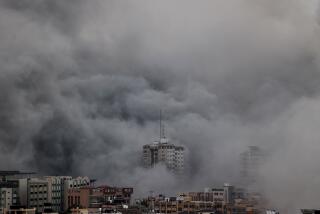Terrorists Taking Up Cyberspace
- Share via
A car bomb shattered storefronts in Netanya, a seaside resort town in northern Israel, and wounded 60 diners and shoppers on the evening of Jan. 1. There was one fatality--the bomber himself.
The group behind this blast didn’t call a TV station to claim credit. Instead Hamas, the Palestinian organization that sponsors acts of terror against Israel, posted a note on its Web site.
It turns out that the Internet--inexpensive, open and accessible at any time from anywhere--is an ideal tool for terrorists.
Scores of guerrilla armies and political factions locked in holy wars and liberation struggles flock to the Net to send messages undiluted by the press and untouched by government censors. Hezbollah and Hamas in the Middle East, guerrillas with the Maoist group Shining Path of Peru and revolutionaries across Europe and Asia operate their own Internet sites. The most popular terrorist sites draw tens of thousands of visitors each month.
Hamas’ Web site presents political cartoons, streaming video clips and photo montages depicting the violent deaths of Palestinian children. The Armed Islamic Group, a fundamentalist sect warring with the Algerian government, posted a detailed bomb-making manual. The online home of the Tamil Tigers, a liberation army in Sri Lanka best known for the 1991 assassination of former Indian Prime Minister Rajiv Gandhi, offers position papers, daily news and peddles free e-mail services. Other terrorist sites post electronic bulletin boards, tips on smuggling money to finance their operations and automated registration for e-mail alerts to foment revolt.
“This is almost a revolutionary change in terrorism,” said Bruce Hoffman, director of the Washington office of Rand Corp., a Santa Monica-based policy research firm. “In the past, terrorists had to communicate through an act of violence and hope that the communique would effectively explain their ideological justification or their fundamental position,” Hoffman said.
Experts still are unclear whether the ability to communicate online worldwide is prompting an increase or a decrease in terrorist acts. But they agree that online activities substantially improve the ability of such terrorist groups to raise funds, lure new faithful and reach a mass audience.
“There is a tendency to think that these people are not computer savvy, that they run around with [AK-47s] and that’s about it,” said Ben Venzke, an intelligence researcher at IDefense, a Fairfax, Va., computer security company. But the Internet “is the perfect vehicle for them to generate support.”
Yet the federal government has lagged in responding to this surge of terror groups online. “I give us a ‘C-minus’ in following these issues,” said a U.S. counter-terrorism official who requested anonymity. “We’re still trying to get our arms around exactly what we’re dealing with.”
Terrorists rarely rely on their Web sites to communicate within their groups. More commonly, they use encrypted--or digitally scrambled--e-mail, according to the FBI. But even that method is widely distrusted.
“The FBI has developed a system to intercept [and read e-mail]. The British intelligence [agency] MI-5 and Scotland Yard have developed similar programs,” said Isaac Velazco Fuertes, Web manager for Peru’s Tupac Amaru Revolutionary Movement, in an interview from Germany, where the group’s main Web site is based. “We believe that to communicate among members using [our Web sites or e-mail] is to be exposed.”
To solve the problem, some terrorists place seemingly innocuous messages that contain coded instructions on outsiders’ Web site bulletin boards. Others hide messages within digital images. Islamic extremists, including some connected to Osama bin Laden--the accused mastermind of the deadly bombings of U.S. embassies in Tanzania and Kenya in 1998--embed encrypted messages within pornography, then post such images on public Web sites. The intended recipients download the images, then extract and decrypt the messages.
“The value of this technique [is that] much like a classified ad,” Venzke said, “the sender doesn’t even need to know who the recipient is.”
Terrorist Web sites have become important enough to become targets. Since the Palestinian uprising last fall, Israeli hackers have repeatedly struck the Web sites of Hezbollah, a Lebanese-based Islamic group behind the 1983 suicide truck bombing of the U.S. Embassy and military barracks in Beirut.
Hackers replaced Hezbollah’s Web logo, a raised fist clenched around an automatic weapon, with photos of Israelis captured by Hezbollah set against a field of waving Israeli flags.
“You can see logically why [the Internet is] important to us--the other side is trying to do everything to stop our efforts,” said Malik Hussein, a Hezbollah member who founded the group’s collection of Web sites five years ago. Speaking by phone from Beirut, Hussein noted that Israeli hackers knocked his service offline for 16 hours in December and wiped clean the host computers’ storage drives.
For their part, pro-Palestinian hackers temporarily overwhelmed the Web sites of Israel’s army, foreign ministry and parliament with a torrent of electronic demands. Scores of Israeli and Palestinian Web sites have been vandalized.
Pakistani and Indian computer hackers have done the same in response to the bloody conflict between those nations over Kashmir.
“When tensions arise on the ground, you see a parallel rise of activity in cyberspace,” said Venzke, who recently completed a report on the Web wars for commercial clients.
And no matter how much a group may revile the United States, most factions translate their sites into English, the Web’s lingua franca.
“You can’t work on the Internet if you don’t know English very well,” said Hezbollah’s Hussein, who was educated in Europe and is fluent in English.
American firms also play a significant role in back-office support for some terrorist sites, according to Internet-address registration records.
At least a dozen terrorist sites use American Internet providers, such as Trumbull, Conn.-based OLM (Hamas and the Tamil Tigers); and LanMinds in Berkeley (Mojahedin-e Khalq, an Iranian leftist group involved in the 1979 takeover of the U.S. Embassy there and which now fights the nation’s clerical regime).
A UC San Diego student group maintains the “Burn!” Web site that hosts offerings from a wide range of radical-left organizations, including an English-language version of the Tupac Amaru site. The Peruvian guerrillas are one of 29 groups officially designated on the U.S. State Department’s foreign terrorist list. Tupac Amaru seized the Japanese Embassy in Lima in 1996, taking more than 400 hostages. A UCSD spokesperson said the university neither endorses nor censors the site, which operates on UC computers.
And until recently Interland Inc., a medium-size Internet service provider in Atlanta, hosted several Hezbollah Web sites. The company said it terminated contracts with three Hezbollah sites in December and January for unspecified violations of its usage agreement. Hezbollah then switched to a Lebanese provider.
The company also hosts the Web site for the U.N. mission addressing the Taliban regime, Islamic fundamentalists who rule most of Afghanistan. The Taliban was severely sanctioned in January by the U.N. for harboring terrorists, including Bin Laden.
Many terrorist sites seem to preach to the converted, but others build surprisingly diverse audiences. Hezbollah claims 40,000 visitors per month to its sites--a paltry showing compared with the 50-million-plus on Yahoo or America Online. But they have proved influential. In one case,541615482oners swap. Israel only reported the return of one soldier’s body, although the remains of two others also were returned. The army secretly buried the remains.
“Only after Israel learned that the Hezbollah planned to [and ultimately did] post the information on its Internet site did [the Israeli military] decide to pass the information on to the two families,” the Israeli newspaper Ha’aretz reported. A scandal ensued.
Last summer, Israelis seeking information on the fighting in southern Lebanon looked to Hezbollah Web sites for news or images of casualties that may not have appeared in the Israeli press due to military censorship, Hoffman said.
Given the violence by many national governments against political opponents, the definition of “terrorist” can be murky. In the United States, Web sites are protected by the 1st Amendment. The FBI does not track visitors to the sites or monitor content unless it is investigating a specific illegal activity, a spokesman said. But U.S. law does prohibit fund-raising by groups on the State Department list of foreign terrorists.
One organization that apparently fell afoul of that rule recently was the Brooklyn, N.Y.-based Hatikva Jewish Identity Center. That group operates https://www.kahane.org, named for the anti-Arab extremist Rabbi Meir Kahane, who was slain a decade ago. Two organizations Kahane or his supporters founded, Kach and Kahane Chai, were placed on the State Department list after a Kach member massacred 48 worshipers at a West Bank mosque in 1994. Kahane.org calls for the expulsion of all Arabs from Israel and solicits donations for its work.
On Jan. 4, the FBI raided Hatikva and carried away computers and documents. Hatikva views the raid as an effort to establish links between it and Kach and Kahane Chai. “I can tell from the search warrant . . . that they are clearly trying to frighten anyone from contributing funds,” said Mike Guzovsky, a Hatikva official, in a recording posted on the Web site.
Some terrorist groups rely on supporters to raise funds online.
One such fund-raiser is Azzam Publications in London. Azzam operates a site dedicated to worldwide jihad and its site steers funds to the Taliban in Afghanistan and to allied guerrillas fighting the Russians in Chechnya.
Taliban’s assets abroad have been frozen by U.N. mandate. But the Azzam site states, “An appeal for cash donations is especially urgent” and advises the personal delivery of U.S. currency to the Taliban consul-general in Karachi, Pakistan, and suggests a $20,000 minimum donation.
“It is probably advisable to send one or two trustworthy, young, strong, fit Muslims with the delegation for protection of the money and the delegation,” the instructions caution, suggesting ways to dodge nosy airport officials. “Under no circumstances should you hand over the money to anyone at the consulate other than the consul-general.”
Possibly the most accomplished Internet fund-raiser is Lashkar-e-Taiba (“Army of the Pure”), a Taliban ally that maintains a guerrilla army battling the Indian military for control over the Kashmir region bordering Pakistan.
Lashkar-e-Taiba’s sophisticated Web site offers Arabic, Urdu and English versions, attractive illustrations and easy pull-down menus that resemble Microsoft Windows.
The site describes how the Mujahideen-e-Lashkar-e-Taiba is fighting the “oppressive Hindu Army in the snow covered valleys, mountains and jungles of Kashmir. These Mujahideen best deserve your [charity].” The site directs donations to a bank in Pakistan; the bank’s phone and the account number are conveniently provided for wire transfers.
Their effort has been so successful that Lashkar-e-Taiba may soon become the envy of like-minded groups that have discovered the Internet. Lashkar-e-Taiba is reportedly planning to open its own bank.
*
Times staff writer Mary Curtius in Jerusalem contributed to this report.
*
More Inside
Terrorism Warning: A former aide to Osama bin Laden testified that he told authorities in 1996 about a plot to attack a U.S. embassy, A20
More to Read
Sign up for Essential California
The most important California stories and recommendations in your inbox every morning.
You may occasionally receive promotional content from the Los Angeles Times.













